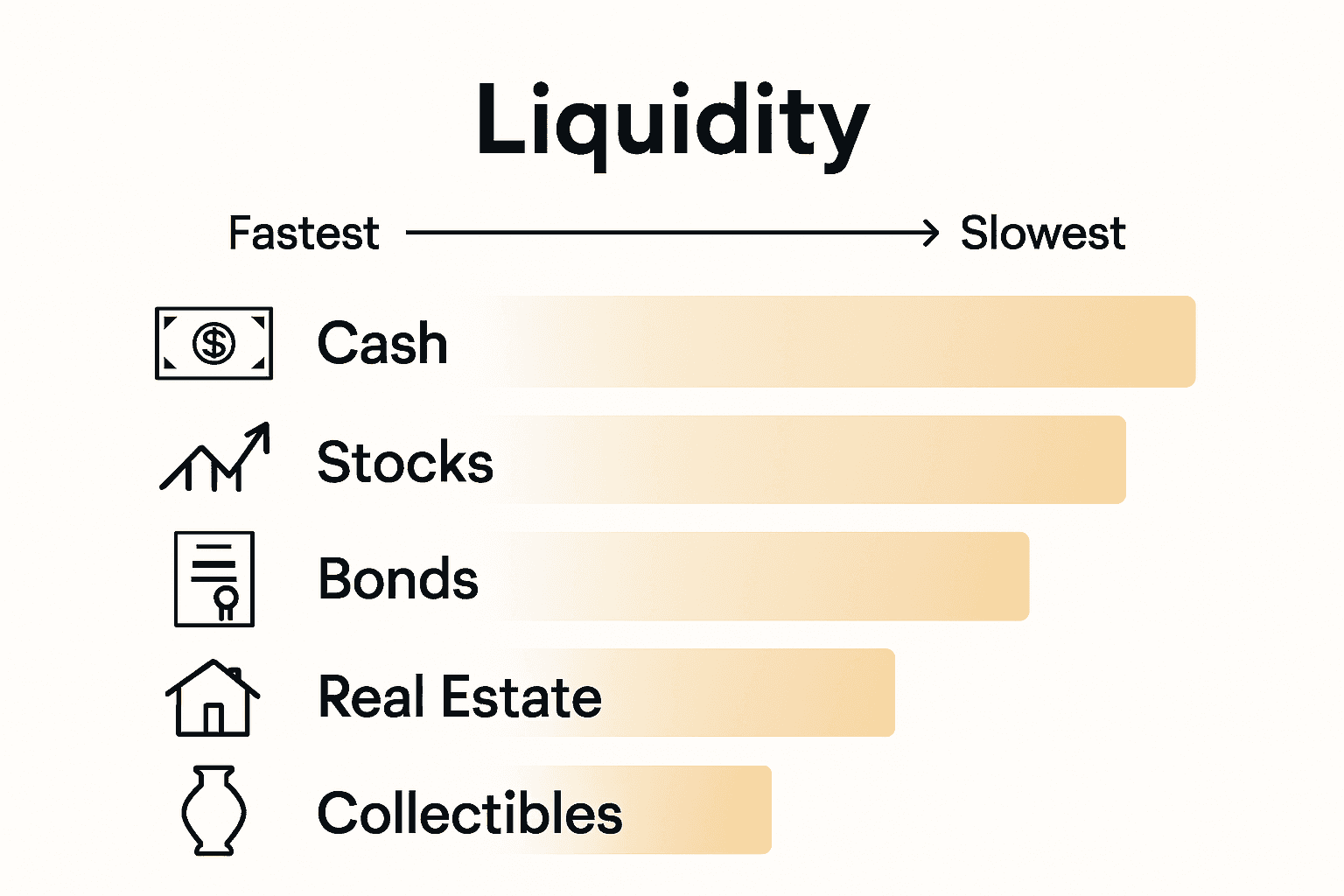Most american investors underestimate how much liquidity shapes their portfolio risk and daily decisions. Over 60 percent of individual investors cite trouble selling assets quickly without losses during volatile times. Grasping the concept of liquidity can mean the difference between meeting a crucial goal and missing out when opportunities arise. This guide breaks down the essentials, so you can understand what liquidity means for your money and how it affects every investment choice you make.
Table of Contents
- Defining Liquidity In Investing
- Types Of Liquidity Investors Should Know
- How Liquidity Functions In Markets
- Measuring Liquidity In Investments
- Liquidity Risks And Cost Implications
- Liquidity Management And Alternatives
Key Takeaways
| Point | Details |
|---|---|
| Understanding Liquidity | Liquidity is crucial for financial strategy, as it indicates how quickly assets can be converted to cash without significant price impact. |
| Types of Liquidity | Different kinds of liquidity include market, accounting, and funding liquidity, each affecting financial flexibility in various ways. |
| Measuring Liquidity | Investors should use metrics like bid-ask spreads and trading volume to assess liquidity and make informed trading decisions. |
| Liquidity Risk Management | Effective liquidity management involves maintaining cash reserves and using low-risk investments to navigate financial uncertainties. |
Defining Liquidity In Investing
In the world of investing, liquidity represents a fundamental concept that can make or break your financial strategy. According to Wikipedia, liquidity refers to the ease with which an asset can be converted into cash without significantly affecting its price. Think of liquidity like water flowing smoothly through a system – some investments are like rapids, while others are more like a slow-moving stream.
Market liquidity emerges as a critical characteristic that determines how quickly you can buy or sell an investment. Wikipedia highlights that market liquidity represents a delicate balance between transaction speed and price stability. When a market is highly liquid, you can execute trades rapidly without causing dramatic price fluctuations. Imagine selling stocks in a bustling marketplace where multiple buyers are ready and willing to purchase your assets at fair market value.
Understanding liquidity involves recognizing different types of financial assets and their convertibility. Some investments are more liquid than others:
- Cash: The most liquid asset, instantly spendable
- Stocks: Generally highly liquid, especially for large companies
- Bonds: Moderate liquidity, depends on market conditions
- Real Estate: Typically low liquidity, requiring significant time to sell
- Collectibles: Often the least liquid, with uncertain market demand
Investors must carefully assess an asset’s liquidity before committing funds. A highly liquid investment offers flexibility, allowing you to respond quickly to changing financial needs or market opportunities.
 Conversely, illiquid assets might lock up your capital for extended periods, potentially limiting your financial maneuverability. By understanding and strategically managing liquidity, you can build a more responsive and adaptable investment portfolio.
Conversely, illiquid assets might lock up your capital for extended periods, potentially limiting your financial maneuverability. By understanding and strategically managing liquidity, you can build a more responsive and adaptable investment portfolio.
Types Of Liquidity Investors Should Know
Investors navigate a complex financial landscape where understanding different types of liquidity is crucial for making informed decisions. According to Wikipedia, liquidity manifests in multiple forms, each playing a critical role in financial strategy and risk management. These variations provide investors with nuanced insights into how assets can be converted, managed, and evaluated.
Market Liquidity represents the ease with which an asset can be bought or sold without causing significant price changes. Accounting Liquidity focuses on a company’s or investor’s ability to meet short-term financial obligations using available assets. Funding Liquidity examines the availability of credit and the capacity to secure financial resources when needed. Each type offers a unique perspective on financial flexibility and potential risk.
The complexities of liquidity extend beyond simple definitions. The liquidity premium theory explains why less liquid assets typically offer higher yields. This compensation reflects the additional risk investors assume when committing to investments that cannot be quickly converted to cash.
Key types of liquidity every investor should understand include:
- Market Liquidity: Speed and ease of trading assets
- Accounting Liquidity: Short-term financial obligation capacity
- Funding Liquidity: Credit and financial resource availability
- Operational Liquidity: Cash flow management for daily transactions
- Systemic Liquidity: Overall market-wide financial system health
By understanding safe investment options, investors can strategically balance their portfolios across different liquidity types. This approach minimizes risk while maintaining financial flexibility, allowing you to adapt to changing economic conditions and personal financial needs.

How Liquidity Functions In Markets
Market liquidity represents the intricate mechanism that enables smooth financial transactions across various investment platforms. According to Wikipedia, market liquidity ensures that assets can be quickly bought or sold without causing significant price changes, creating a delicate balance between transaction speed and price stability. Think of it like a well-oiled machine where buyers and sellers can seamlessly exchange assets with minimal friction.
The functioning of market liquidity depends on several critical factors. Bid-ask spreads, trading volume, and the number of active market participants all contribute to determining how efficiently assets can be converted. When markets are highly liquid, investors can enter or exit positions rapidly without experiencing substantial price distortions. Conversely, illiquid markets create challenges where trading becomes more expensive and time-consuming.
Understanding liquidity at risk provides deeper insights into market dynamics. Wikipedia explains liquidity at risk (LaR) as a method for measuring potential net cash outflows an institution might face, which helps investors and financial managers model potential scenarios and assess funding adequacy under various market conditions.
Key components that drive market liquidity include:
- Trading Volume: Higher transaction numbers indicate stronger liquidity
- Market Depth: Number of buy and sell orders at different price levels
- Asset Characteristics: Some securities are naturally more liquid than others
- Market Sentiment: Investor confidence impacts trading activity
- Economic Conditions: Broader economic factors influence market participation
By understanding short term investment options, investors can strategically navigate market liquidity, making informed decisions that balance risk, potential returns, and transaction flexibility. The ability to quickly assess and respond to market liquidity conditions can significantly enhance your investment strategy.
Measuring Liquidity In Investments
Liquidity measurement is a sophisticated process that helps investors understand the ease of converting investments into cash. According to research from arXiv, critical frameworks for modeling market liquidity emphasize the importance of bid-ask spreads and intra-daily measures in capturing market dynamics and information flow. These metrics provide investors with nuanced insights into how quickly and efficiently they can trade their assets.
Investors employ multiple sophisticated techniques to assess liquidity. Bid-ask spreads represent the difference between the highest price a buyer will pay and the lowest price a seller will accept. Narrower spreads typically indicate higher liquidity, suggesting more active trading and easier asset conversion. Trading volume, market depth, and turnover rate are additional critical indicators that help investors gauge the potential ease of executing trades without significant price impact.
Recent research from arXiv highlights advanced approaches to liquidity analysis, introducing machine learning techniques that evaluate key liquidity metrics. The study emphasizes three primary liquidity indicators: Liquidity Ratio, Flow Ratio, and Turnover Rate. These sophisticated metrics provide deeper insights into potential price movements and market behavior, allowing investors to make more informed decisions.
Key liquidity measurement techniques include:
- Bid-Ask Spread: Difference between buying and selling prices
- Trading Volume: Total number of shares or assets traded
- Market Depth: Number of buy and sell orders at different price levels
- Turnover Rate: Frequency of asset trading within a specific period
- Liquidity Ratio: Comparing liquid assets to short-term liabilities
By understanding short term investment options, investors can develop a more comprehensive approach to measuring and interpreting liquidity. This knowledge enables more strategic investment decisions, helping you navigate market complexities with greater confidence and precision.
Liquidity Risks And Cost Implications
Liquidity risk represents a critical challenge for investors, demanding careful strategic navigation through complex financial landscapes. According to Wikipedia, liquidity risk emerges when securities cannot be quickly bought or sold without impacting their price, potentially leading to substantial losses in volatile market conditions. This risk transforms seemingly stable investments into potential financial minefields.
Research from arXiv provides deeper insights into how liquidity costs influence investment outcomes. The study reveals that liquidity costs significantly impact the relationship between expected idiosyncratic volatility and stock returns. Bid-ask bounce and microstructure noise can create hidden financial complexities that unexpectedly alter return estimations, making precise risk assessment crucial for investors.
Investors face multiple dimensions of liquidity-related financial challenges. Transaction costs, market impact, and potential price distortions represent key risk factors that can erode investment returns. When markets become less liquid, investors might encounter scenarios where selling assets becomes difficult or results in substantial value reduction. These risks are particularly pronounced during market downturns or when dealing with less mainstream investment instruments.
Key liquidity risk considerations include:
- Bid-Ask Spread Widening: Increased trading costs
- Market Depth Reduction: Fewer buyers and sellers
- Price Volatility: Higher potential for unexpected value changes
- Transaction Delays: Difficulty executing trades quickly
- Hidden Transaction Costs: Unexpected fees and price impacts
By understanding short term investment options, investors can develop robust strategies to mitigate liquidity risks. Diversification, careful asset selection, and maintaining a comprehensive understanding of market dynamics become essential tools in managing these potential financial challenges.
Liquidity Management And Alternatives
Liquidity management represents a critical strategic approach for investors seeking to balance financial flexibility and investment performance. According to research from Oxford Academic, effective liquidity management requires careful allocation of decision-making power within investment frameworks. This approach helps investors navigate complex financial landscapes while maintaining optimal asset convertibility.
Innovative research is continuously expanding our understanding of liquidity strategies. arXiv introduces advanced liquidity premium measures and liquidity-adjusted return models, demonstrating remarkable predictability especially in volatile asset classes like cryptocurrency. These sophisticated techniques enable investors to develop more nuanced approaches to managing financial resources, moving beyond traditional liquidity assessment methods.
Investors have multiple alternatives for managing liquidity risk and maintaining financial flexibility. Cash equivalents, money market funds, and short-term government securities provide readily accessible investment options with minimal value fluctuation. Strategic diversification across these instruments allows investors to maintain a balance between accessibility and potential returns, creating a robust financial buffer against unexpected market changes.
Key liquidity management alternatives include:
- Cash Reserves: Immediate financial accessibility
- Money Market Funds: Low-risk, short-term investments
- Treasury Bills: Government-backed liquid securities
- Certificates of Deposit: Structured savings with predictable returns
- Liquid ETFs: Easily tradable investment instruments
By understanding short term investment options, investors can craft comprehensive liquidity management strategies that balance accessibility, risk, and potential growth. The key lies in developing a flexible approach that adapts to changing financial landscapes and personal investment goals.
Master Liquidity to Strengthen Your Investment Strategy
Navigating liquidity challenges is essential for any serious investor. This guide revealed critical concepts like market liquidity, liquidity risk, and effective liquidity management that directly impact your ability to convert assets without loss. If you have struggled with understanding liquidity’s role in building a flexible portfolio or want to avoid costly surprises from illiquid investments now is the time to take action.
Discover how you can balance your investments and protect yourself from liquidity pitfalls by exploring practical solutions at finblog.com. Whether you want to learn more about short term investment options that offer quick access to cash or need expert guidance on managing liquidity risk effectively, our resources are designed for you.
Don’t let liquidity uncertainty limit your financial goals. Visit https://finblog.com today and empower yourself with knowledge and strategies that keep your portfolio adaptable and responsive to any market condition.
Frequently Asked Questions
What is liquidity in investing?
Liquidity in investing refers to the ease with which an asset can be converted into cash without significantly affecting its price. Highly liquid assets can be quickly sold with minimal price impact, while illiquid assets may take longer to sell and might require a discount to their market value.
Why is market liquidity important for investors?
Market liquidity is crucial because it determines how quickly and efficiently assets can be bought or sold. High market liquidity allows investors to execute trades rapidly without causing drastic price changes, providing flexibility in responding to market conditions.
What are the different types of liquidity that investors should know?
Investors should understand several types of liquidity, including market liquidity (ease of buying/selling assets), accounting liquidity (ability to meet short-term obligations), funding liquidity (availability of credit), operational liquidity (management of cash flow), and systemic liquidity (health of the overall financial system).
How can investors measure liquidity in their investments?
Investors can measure liquidity using various metrics such as bid-ask spreads, trading volume, market depth, turnover rate, and liquidity ratios. These indicators help assess how easily assets can be traded and can provide insights into potential market behavior.










